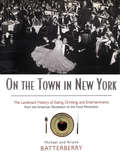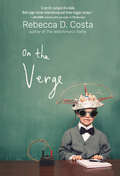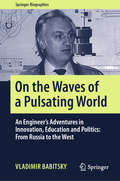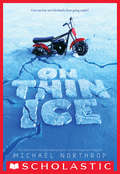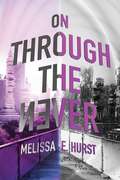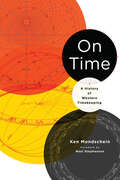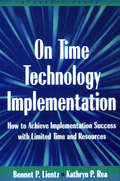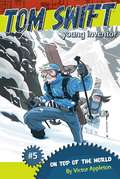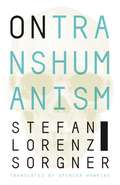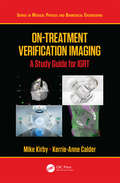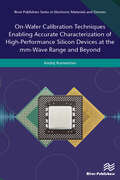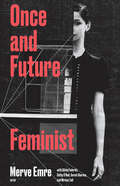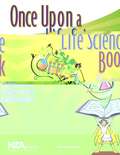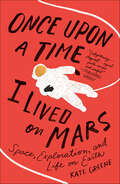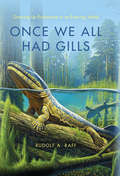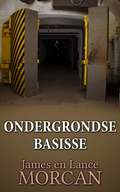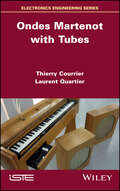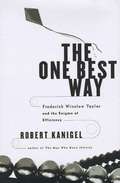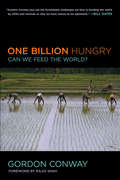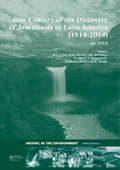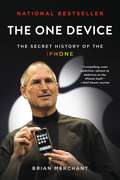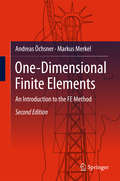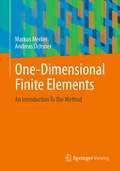- Table View
- List View
On the Town in New York: The Landmark History of Eating, Drinking, and Entertainments from the American Revolution to the Food Revolution
by Michael Batterberry Ariane BatterberryFirst Published in 1998. Routledge is an imprint of Taylor & Francis, an informa company.
On the Verge
by Rebecca D. CostaThe author of The Watchman&’s Rattle &“has done it again. On the Verge shows how predictive technologies and science are redefining modern leadership&” (George Mitchell, former Senate Majority Leader). &“There can be no greater advantage than certainty of the future. Not in nature. Not in business. Not in governance.&” So begins Rebecca Costa&’s much-awaited exploration of foresight: &“the crowning achievement of human ambition.&” According to Costa, advances in Big Data, predictive analytics, genomics, artificial intelligence, and other breakthroughs have made it possible to pinpoint future results with mind-blowing accuracy—cracking the door to what Costa calls predaptation: the ability to adapt before the fact. Never before has the information needed to avert danger, get the jump ahead of others, or prepare for the inevitable been so clearly within grasp. Through fascinating real-life examples, Costa reveals how technology has brought nations, businesses, and individuals to the edge of clairvoyance. Yet, our ability to act on foreknowledge often falls short—causing leaders to squander the advantage of preemption. To counteract this failure, Costa illuminates 12 principles of adaptation, and predaptation, used to succeed in fast-moving environments. In the spirit of the best in popular science, On the Verge is a landmark examination of big-picture forces affecting society today. Costa&’s unique sociobiological perspective, combined with her ability to blend humor, breaking science, and insightful personal stories, distinguishes her as one of the most important thought leaders of our time. &“If you have an insatiable curiosity about the impact of innovation on our world ahead and how the future can be manipulated, you will love this book.&”—John Sculley, former CEO of Apple and President of Pepsi-Cola
On the Waves of a Pulsating World: An Engineer’s Adventures in Innovation, Education and Politics: From Russia to the West (Springer Biographies)
by Vladimir BabitskyVladimir Babitsky was born before the Second World War and migrated West after Perestroika. The theory of vibro-impact systems that he developed helped create the world’s safest jackhammer and other record-breaking machines. The author has lived through a series of fascinating epochs: experiencing life under totalitarianism, witnessing the Soviet Union’s collapse, and then migrating to Europe as a specialist in his field. “On the Waves of a Pulsating World” is an animated and highly engaging story about the journey of an engineer; from childhood daydreams to creating new technologies, from East to West, and from concepts to realities. It is also the story of people who outshine authoritarianism.
On Thin Ice (Scholastic Press Novels Ser.)
by Michael NorthropNew York Times bestselling author Michael Northrop captures the middle-school experience -- from the hurt and horror to the hope -- in this powerful story of acceptance and identity.If I did something risky now, something big -- it's almost like it wouldn't even be my fault. Almost like it might even work.Ked Eakins is about to lose everything.He's just discovered that his dad has gambled away their rent money. They're going to get kicked out of their home.But Ked is determined to fight back. He hatches a plan to save their apartment by rebuilding a vintage minibike in his school's maker space, which he'll sell for a profit.Still, the plan is a gamble of his own: Going to maker space forces Ked into the path of a school bully, who torments him about his progressive spinal condition.Can Ked -- with the help of some unlikely new friends -- find a way to fix the bike and save his family from going under before it's too late?New York Times bestselling author Michael Northrop has written a powerful story a boy who -- against all odds -- decides to bet on himself and create something new from broken pieces.
On Through the Never
by Melissa E. HurstIn 2013, Bridger and Alora found a way to prevent Alora’s murder and return her to the century she was born in, preserving the timeline and preventing a possibly disastrous future. Back in the year 2147, Bridger is following in his father’s footsteps by wrapping up his military training at The Academy for Time Travel and Research. Alora is adjusting to life in the twenty-second century, and learning to master her powers; as a Dual Talent, she has the rare—and secret—ability to bend both space and time. But unrest is growing in the North American Federation. As the government moves to limit the rights of Purists, people who refuse genetic modifications, violent protests break out. At the same time, paranoia and anger about the existence of Dual Talents seems to be growing—both among Purists and within the government itself. Then a masked Time Bender arrives from the future. He insists that war is coming, and only Bridger and Alora can stop it. There’s just one problem: they have no memory of each other.
On Time: A History of Western Timekeeping
by Kenneth MondscheinAn approachable, accessible history of timekeeping and the impact of the increasing precision and accuracy of time on humanity.Western culture has been obsessed with regulating society by the precise, accurate measurement of time since the Middle Ages. In On Time, Ken Mondschein explores the paired development of concepts and technologies of timekeeping with human thought. Without clocks, he argues, the modern world as we know it would not exist. From the astronomical timekeeping of the ancient world to the tower clocks of the Middle Ages to the seagoing chronometer, the quartz watch, and the atomic clock, greater precision and accuracy have had profound effects on human society—which, in turn, has driven the quest for further precision and accuracy. This quest toward automation—which gave rise to the Gregorian calendar, the factory clock, and even the near-disastrous Y2K bug—has led to profound social repercussions and driven the creation of the modern scientific mindset. Surveying the evolution of the clock from prehistory to the twenty-first century, Mondschein explains how both the technology and the philosophy behind Western timekeeping regimes came to take over the entire world. On Time is a story of thinkers, philosophers, and scientists, and of the thousand decisions that continue to shape our daily lives.
On Time Technology Implementation
by Bennet Lientz Kathryn ReaOn Time Technology Implementation presents technology implementation guidelines and lessons learned from over 30 years of successful, hands-on project experience.
On Top of the World
by Victor AppletonHigh elevations equal high stakes for Tom! Tom is headed to Mount Everest. Not only will he get some sweet practice time in on his new foil kite snowboard, but he and Bud are going to put his latest invention--a robot Sherpa--to the test. At Everst's high elevations they will really be able to run the Sherpa through its paces. But Tom can't quite focus on the tasks at hand because while there are always rumors of the mysterious Yeti, Tom thinks he's seen one. And what's more is that there's a nasty bunch of hunters on the prowl to capture the yeti "at any cost." Tom knows that some things are better left a mystery and vows to do what he can to protect this natural environment--and any mysterious species inhabiting it.
On Transhumanism
by Stefan Lorenz SorgnerTranshumanism is widely misunderstood, in part because the media have exaggerated current technologies and branded the movement as dangerous, leading many to believe that hybrid humans may soon walk among us and that immortality, achieved by means of mind-uploading, is imminent. In this essential and clarifying volume, Stefan Lorenz Sorgner debunks widespread myths about transhumanism and tackles the most pressing ethical issues in the debate over technologically assisted human enhancement.On Transhumanism is a vital primer on the subject, written by a world-renowned expert. In this book, Sorgner presents an overview of the movement’s history, capably summarizing the twelve pillars of transhumanist discourse and explaining the great diversity of transhumanist responses to each individual topic. He highlights the urgent ethical challenges related to the latest technological developments, inventions, and innovations and compares the unique cultural standing of transhumanism to other cultural movements, placing it within the broader context of the Enlightenment, modernity, postmodernity, and the philosophical writings of Nietzsche. Engagingly written and translated and featuring an introduction for North American readers, this comprehensive overview of the cultural and philosophical movement of transhumanism will be required reading for students of posthumanist philosophy and for general audiences interested in learning about the transhumanist movement.
On Transhumanism
by Stefan Lorenz SorgnerTranshumanism is widely misunderstood, in part because the media have exaggerated current technologies and branded the movement as dangerous, leading many to believe that hybrid humans may soon walk among us and that immortality, achieved by means of mind-uploading, is imminent. In this essential and clarifying volume, Stefan Lorenz Sorgner debunks widespread myths about transhumanism and tackles the most pressing ethical issues in the debate over technologically assisted human enhancement.On Transhumanism is a vital primer on the subject, written by a world-renowned expert. In this book, Sorgner presents an overview of the movement’s history, capably summarizing the twelve pillars of transhumanist discourse and explaining the great diversity of transhumanist responses to each individual topic. He highlights the urgent ethical challenges related to the latest technological developments, inventions, and innovations and compares the unique cultural standing of transhumanism to other cultural movements, placing it within the broader context of the Enlightenment, modernity, postmodernity, and the philosophical writings of Nietzsche. Engagingly written and translated and featuring an introduction for North American readers, this comprehensive overview of the cultural and philosophical movement of transhumanism will be required reading for students of posthumanist philosophy and for general audiences interested in learning about the transhumanist movement.
On-Treatment Verification Imaging: A Study Guide for IGRT (Series in Medical Physics and Biomedical Engineering)
by Mike Kirby Kerrie-Anne CalderOn-treatment verification imaging has developed rapidly in recent years and is now at the heart of image-guided radiation therapy (IGRT) and all aspects of radiotherapy planning and treatment delivery. This is the first book dedicated to just this important topic, which is written in an accessible manner for undergraduate and graduate therapeutic radiography (radiation therapist) students and trainee medical physicists and clinicians. The later sections of the book will also help established medical physicists, therapeutic radiographers, and radiation therapists familiarise themselves with developing and cutting-edge techniques in IGRT. Features: Clinically focused and internationally applicable; covering a wide range of topics related to on-treatment verification imaging for the study of IGRT Accompanied by a library of electronic teaching and assessment resources for further learning and understanding Authored by experts in the field with over 18 years’ experience of pioneering the original forms of on-treatment verification imaging in radiotherapy (electronic portal imaging) in clinical practice, as well as substantial experience of teaching the techniques to trainees
On-Wafer Calibration Techniques Enabling Accurate Characterization of High-Performance Silicon Devices at the mm-Wave Range and Beyond (River Publishers Series In Electronic Materials And Devices Ser.)
by Andrej RumiantsevThe increasing demand for more content, services, and security drives the development of high-speed wireless technologies, optical communication, automotive radar, imaging and sensing systems and many other mm-wave and THz applications. S-parameter measurement at mm-wave and sub-mm wave frequencies plays a crucial role in the modern IC design debug. Most importantly, however, is the step of device characterization for development and optimization of device model parameters for new technologies. Accurate characterization of the intrinsic device in its entire operation frequency range becomes extremely important and this task is very challenging.This book presents solutions for accurate mm-wave characterization of advanced semiconductor devices. It guides through the process of development, implementation and verification of the in-situ calibration methods optimized for high-performance silicon technologies.Technical topics discussed in the book include: Specifics of S-parameter measurements of planar structures Complete mathematical solution for lumped-standard based calibration methods, including the transfer Thru-Match-Reflect (TMR) algorithms Design guideline and examples for the on-wafer calibration standards realized in both advanced SiGe BiCMOS and RF CMOS processes Methods for verification of electrical characteristics of calibration standards and accuracy of the in-situ calibration results Comparison of the new technique vs. conventional approaches: the probe-tip calibration and the pad parasitic de-embedding for various device types, geometries and model parameters New aspects of the on-wafer RF measurements at mmWave frequency range and calibration assurance.
Once-a-Month Cooking Family Favorites: More Great Recipes That Save You Time and Money from the Inventors of the Ultimate Do-ahead Dinnertime Method
by Mary Beth Lagerborg Mimi WilsonWilson and Lagerborg are back with a new book that features their Once-A-Month Cooking technique--guaranteed to save time and money.
Once and Future Feminist (Boston Review)
by Merve EmreFeminist writers and scholars consider whether technology has made good on its promise to liberate women—sexually, biologically, economically, and politically. In Once and Future Feminist, editor and lead essayist Merve Emre turns a critical eye on the role of technology in feminism both past and present. With her starting point the “fertility benefits” offered by Silicon Valley tech companies, Emre posits that such reproductive technologies as egg freezing and in vitro fertilization aren't inherently emancipatory; they often make women even more vulnerable to exploitation in the workplace. Almost fifty years ago, radical feminist Shulamith Firestone viewed developments in reproductive technology with skepticism, arguing in The Dialectic of Sex that they are only "incidentally in the interests of women when at all.” Engaging other feminist writers and scholars, this collection broadens out to examine whether technology in general has made good on its promise to liberate women—sexually, biologically, economically, and politically. In this context, Once and Future Feminist considers not only whether or not a radical, emancipatory feminism is possible today but what such a feminism might look like. Contributors Irina Aristarkhova, Michael Bronski, James Chappell, Mary Darnovsky, Silvia Federici, Chris Kaposy, Sophie Lewis, Andrea Long Chu, Annie Menzel, Cathy O'Neil, Sarah Sharma, Diane Tober, Miriam Zoll
Once Upon a Life Science Book: 12 Interdisciplinary Activities to Create Confident Readers
by Jodi Wheeler-ToppenWheeler-Toppen, a science teacher and children's author, presents 12 inquiry-based classroom lessons to help middle school teachers improve students' reading abilities and teach science content at the same time. Each lesson consists of a science activity, a reading about an important life science concept (easier to follow than those typically found in textbooks), an application that asks students to connect the activity with what they read, and a reading comprehension exercise, such as previewing illustrations, identifying text structures, and context clues to the meanings of new words. Each lesson also includes a graphic organizer and a writing activity. Six of the lessons ask students to make a claim and support it with evidence, and an introductory chapter suggests activities to help students understand claims and evidence.
Once Upon a Time I Lived on Mars: Space, Exploration, and Life on Earth
by Kate GreeneWhen it comes to Mars, the focus is often on how to get there: the rockets, the engines, the fuel. But upon arrival, what will it actually be like?In 2013, Kate Greene moved to Mars. That is, along with five fellow crew members, she embarked on NASA’s first HI-SEAS mission, a simulated Martian environment located on the slopes of Mauna Loa in Hawai'i. For four months she lived, worked, and slept in an isolated geodesic dome, conducting a sleep study on her crew mates and gaining incredible insight into human behavior in tight quarters, as well as the nature of boredom, dreams, and isolation that arise amidst the promise of scientific progress and glory.In Once Upon a Time I Lived on Mars, Greene draws on her experience to contemplate humanity’s broader impulse to explore. The result is a twined story of space and life, of the standard, able-bodied astronaut and Greene’s brother’s disability, of the lag time of interplanetary correspondences and the challenges of a long-distance marriage, of freeze-dried egg powder and fresh pineapple, of departure and return. By asking what kind of wisdom humanity might take to Mars and elsewhere in the Universe, Greene has written a remarkable, wide-ranging examination of our time in space right now, as a pre-Mars species, poised on the edge, readying for launch.
Once We All Had Gills
by Rudolf A. RaffIn this book, Rudolf A. Raff reaches out to the scientifically queasy, using his life story and his growth as a scientist to illustrate why science matters, especially at a time when many Americans are both suspicious of science and hostile to scientific ways of thinking. Noting that science has too often been the object of controversy in school curriculums and debates on public policy issues ranging from energy and conservation to stem-cell research and climate change, Raff argues that when the public is confused or ill-informed, these issues tend to be decided on religious, economic, and political grounds that disregard the realities of the natural world. Speaking up for science and scientific literacy, Raff tells how and why he became an evolutionary biologist and describes some of the vibrant and living science of evolution. Once We All Had Gills is also the story of evolution writ large: its history, how it is studied, what it means, and why it has become a useful target in a cultural war against rational thought and the idea of a secular, religiously tolerant nation.
Ondergrondse Basisse
by Elmarié Smal James Morcan Lance MorcanWat vang die wêreld se supermagte in hul geheime ondergrondse bunkers aan? Ondergrondse Basisse gee in die besonder bevestigde en gerugte ondergrondse fasiliteite in die Verenigde State en regoor die wêreld. Dit bevat seldsame fotografiese bewyse dwarsdeur sowel as minder bekende aanhalings uit sleutelregeringsfigure. Dit maak 'n dwingende saak dat daar 'n enorme verborge wêreld onder die Aarde se oppervlak bestaan. Die Morcans spekuleer dat die bedekte ondergrondse infrastruktuur veel groter kan wees as wat voorheen vermoed is en waarskynlik gebruik word vir die ontwikkeling van onderdrukte tegnologie. Hul bronne sluit in verwyderde lêers, universiteitsverslae, WikiLeaks se dokumente en onderhoude met oud-militêre personeel wat verklikkers geword het, wat beweer dat hulle in "stede onder die grond" gewerk het. Ondergrondse basisse lewer 'n wye verskeidenheid feite en teorieë wat uiteindelik lesers toelaat om hul eie gevolgtrekkings te vorm. Die onthulling dek alles van: die Amerikaanse Departement van Verdediging se bevestigde ontruimingsgebiede onder die Wit Huis en die Pentagon, sowel as hul erkende terreine by Mount Weather en Cheyenne Mountain; Ondergrondse fasiliteite regoor die wêreld, insluitend Rusland se uitgestrekte Mezhgorye-kompleks en Australië se CIA-bestuurde Pine Gap; Die langvergete koerantopskrifte wat berig het dat Adolf Hitler en senior SS-beamptes na die Tweede Wêreldoorlog 'n Nazi-kolonie onder Antarktika kon gebou het; Gerugte dat menslike-ruimtewesens gesamentlike ondernemings onder die grond plaasvind en dat ontvoerde burgers in ondergrondse gevangenisse aangehou word vir onwettige mediese eksperimente soos kloning. Waarom spandeer die Globale Adelikes triljoene dollars van hul swart begrotings om sulke groot netwerke van ondergrondse (en ondersese en onderys) terreine te bou? Berei hulle bloot voor vir noodgevalle soos per amptelike regeringsverklarings? Glo hulle dat 'n Armageddon-scenario op hande is? Werk hulle in die gehei
Ondes Martenot with Tubes
by Thierry Courrier Laurent QuartierThe Ondes Martenot is one of the precursors of electronic musical instruments, and is today considered, with the desire for a return to analogue, as a cult instrument. This book, which is the result of several years of research, sheds light on the intrinsic functioning of the Ondes Martenot. Based on the study of numerous prototypes, the authors trace the historical evolution of the different techniques used: additive, multiplicative and relaxation syntheses. Often, the analysis of the functioning of these instruments demonstrates atypical technological choices, underpinned by a logic that places artistic creation at the forefront. Several models and simulations are built, so as to understand the functioning of each of the different sub-assemblies (keyboard, ribbon, intensity key, timbre filter...). At the end of the book, the complete construction of an Onde (copy of model no. 208) is described in detail. This practical realization of a facsimile is an opportunity to explore the knowhow of the electronic luthier Maurice Martenot.
The One Best Way: Frederick Winslow Taylor and the Enigma of Efficiency
by Robert Kanigellandmark biography of Frederick Winslow Taylor--the man whose ceaseless quest for "the one best way"--changed the very texture of twentieth-century life. "In the past man has been first. In the future the System will be first." These are the words of Frederick Winslow Taylor, who in 1874, at the age of eighteen, abandoned his wealthy family's plans for him to attend Harvard and instead went to work as a lowly apprentice in a hot, dirty Philadelphia machine shop. As he rose through the ranks of management, he became the first efficiency expert, progenitor of all the stopwatch-clicking engineers who stalk the factories of the industrial world. Taylor's famous industrial philosophy--Scientific Management--influenced Ford's assembly line and Lenin's Soviet Russia. Management guru Peter Drucker has ranked him with Freud and Darwin as a maker of the modern world. The One Besf Way is the compelling story of this driven man-and a fascinating re-creation of the vanished era of steam and steel in which he lived and worked.
One Billion Hungry: Can We Feed the World?
by Gordon ConwayHunger is a daily reality for a billion people. More than six decades after the technological discoveries that led to the Green Revolution aimed at ending world hunger, regular food shortages, malnutrition, and poverty still plague vast swaths of the world. And with increasing food prices, climate change, resource inequality, and an ever-increasing global population, the future holds further challenges. In One Billion Hungry, Sir Gordon Conway, one of the world's foremost experts on global food needs, explains the many interrelated issues critical to our global food supply from the science of agricultural advances to the politics of food security. He expands the discussion begun in his influential The Doubly Green Revolution: Food for All in the Twenty-First Century, emphasizing the essential combination of increased food production, environmental stability, and poverty reduction necessary to end endemic hunger on our planet. Conway addresses a series of urgent questions about global hunger: - How we will feed a growing global population in the face of a wide range of adverse factors, including climate change? - What contributions can the social and natural sciences make in finding solutions? - And how can we engage both government and the private sector to apply these solutions and achieve significant impact in the lives of the poor? Conway succeeds in sharing his informed optimism about our collective ability to address these fundamental challenges if we use technology paired with sustainable practices and strategic planning. Beginning with a definition of hunger and how it is calculated, and moving through issues topically both detailed and comprehensive, each chapter focuses on specific challenges and solutions, ranging in scope from the farmer's daily life to the global movement of food, money, and ideas. Drawing on the latest scientific research and the results of projects around the world, Conway addresses the concepts and realities of our global food needs: the legacy of the Green Revolution; the impact of market forces on food availability; the promise and perils of genetically modified foods; agricultural innovation in regard to crops, livestock, pest control, soil, and water; and the need to both adapt to and slow the rate of climate change. One Billion Hungry will be welcomed by all readers seeking a multifacted understanding of our global food supply, food security, international agricultural development, and sustainability.
One Century of the Discovery of Arsenicosis in Latin America: Proceedings of the 5th International Congress on Arsenic in the Environment, May 11-16, 2014, Buenos Aires, Argentina (Arsenic in the Environment - Proceedings)
by Marta I. Litter Hugo B. Nicolli Martin Meichtry Natalia Quici Jochen Bundschuh Prosun Bhattacharya Ravi NaiduThe Congress "Arsenic in the Environment" offers an international, multi- and interdisciplinary discussion platform for research aimed towards a holistic solution to the problem posed by the environmental toxin arsenic, with considerable societal impact. The congress has focused on cutting edge and breakthrough research in physical, chemical, toxic
The One Device: The Secret History of the iPhone
by Brian Merchant"The One Device is a tour de force, with fast-paced edge and heaps of analytical insight." -Ashlee Vance, New York Times bestselling author of Elon Musk"A stunning book. You will never look at your iPhone the same way again." -Dan Lyons, New York Times bestselling author of DisruptedThe secret history of the invention that changed everything-and became the most profitable product in the world.Odds are that as you read this, an iPhone is within reach. But before Steve Jobs introduced us to "the one device," as he called it, a cell phone was merely what you used to make calls on the go.How did the iPhone transform our world and turn Apple into the most valuable company ever? Veteran technology journalist Brian Merchant reveals the inside story you won't hear from Cupertino-based on his exclusive interviews with the engineers, inventors, and developers who guided every stage of the iPhone's creation.This deep dive takes you from inside One Infinite Loop to 19th century France to WWII America, from the driest place on earth to a Kenyan pit of toxic e-waste, and even deep inside Shenzhen's notorious "suicide factories." It's a firsthand look at how the cutting-edge tech that makes the world work-touch screens, motion trackers, and even AI-made their way into our pockets.The One Device is a roadmap for design and engineering genius, an anthropology of the modern age, and an unprecedented view into one of the most secretive companies in history. This is the untold account, ten years in the making, of the device that changed everything.
One-Dimensional Finite Elements: An Introduction To The Fe Method
by Markus Merkel Andreas ÖchsnerThis textbook presents finite element methods using exclusively one-dimensional elements. It presents the complex methodology in an easily understandable but mathematically correct fashion. The approach of one-dimensional elements enables the reader to focus on the understanding of the principles of basic and advanced mechanical problems. The reader will easily understand the assumptions and limitations of mechanical modeling as well as the underlying physics without struggling with complex mathematics. Although the description is easy, it remains scientifically correct.The approach using only one-dimensional elements covers not only standard problems but allows also for advanced topics such as plasticity or the mechanics of composite materials. Many examples illustrate the concepts and problems at the end of every chapter help to familiarize with the topics. Each chapter also includes a few exercise problems, with short answers provided at the end of the book.The second edition appears with a complete revision of all figures. It also presents a complete new chapter special elements and added the thermal conduction into the analysis of rod elements. The principle of virtual work has also been introduced for the derivation of the finite-element principal equation.
One-Dimensional Finite Elements: An Introduction To The Method
by Markus Merkel Andreas ÖchsnerThe basic idea of this introduction to the finite element method is based on the concept of explaining the complex method using only one-dimensional elements. Thus, the mathematical description remains largely simple and straightforward. The emphasis in each chapter is on explaining the method and understanding it itself. The reader learns to understand the assumptions and derivations in various physical problems in structural mechanics and to critically assess the possibilities and limitations of the finite element method.The restriction to one-dimensional elements thus enables the methodical understanding of important topics (e.g. plasticity or composite materials), which a prospective computational engineer encounters in professional practice, but which are rarely treated in this form at universities. Thus, an easy entry - also into more advanced application areas - is ensured by the concept of (a) introduction to the basics (b) exact derivation with restriction to one-dimensional elements (and in many cases also to one-dimensional problems) (c) extensive examples and advanced tasks (with short solution in the appendix).For illustration purposes, each chapter is deepened with extensively calculated and commented examples as well as with further tasks including short solutions
